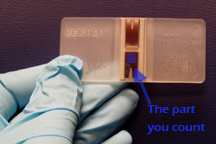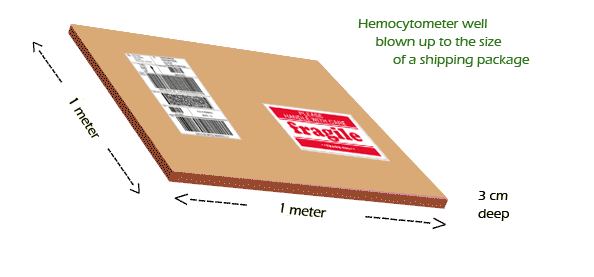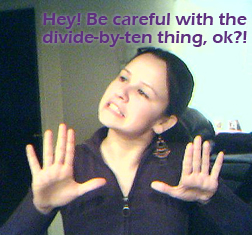Volume is 3D
 As you might have guessed, Nemo did convince Mr. Silver to buy one of those new-fangled hemocytometers. He's just gotten it out of the bubble-wrap, and already he's in trouble.
As you might have guessed, Nemo did convince Mr. Silver to buy one of those new-fangled hemocytometers. He's just gotten it out of the bubble-wrap, and already he's in trouble.
Before he can actually use the hemocytometer, he needs to figure out what it's volume is. The total volume is not too hard: the grid is exactly 3 mm by 3 mm, and 0.1 mm deep. So the volume is:
3mm x 3mm x 0.1 mm = 0.9 mm3
That's the volume of the entire counting chamber. But there are a couple of common mistakes that people make when calculating volumes. If you can learn to avoid these now, it will be easier when we get to calculating volumes of the smaller gridsquares.
 Common mistake #1: "The world is flat"
Common mistake #1: "The world is flat"
Sometimes people forget to multiply by the depth. This is an understandable mistake, since the grid is wide but not very deep. If we blew it up to the size of a (large) shipping package, it would be a box that was a meter square, but only 3 cm thick.

If you make this mistake, you end up with a "volume" of
3 mm x 3 mm = 9 mm2
Volumes should be 3-dimensional, but "9 mm2" has only 2 dimensions. That's a clue that you didn't include all 3 dimensions in the calculation.
 Common mistake #2: "All I need to do is divide by 10"
Common mistake #2: "All I need to do is divide by 10"
What if we need to convert the volume to mLs? A mL is the same as a cubic centimeter, so we need to convert mm3 to cm3.
At some point, most people figure out a shortcut that goes something like this: "to convert mm to centimeters, divide by 10". This is correct as far as it goes, but it doesn't go very far. In this case we need to convert mm3, not just millimeters. The fraction-of-1 conversion method is much more fool proof (or is that scurvy-bilge-rat-proof?). You need to convert mm 3 times, so you multiply by the conversion fraction 3 times:

If this conversion gives you even a moment of unease, please go back and review the module called Follow the Units.
photo credits: hemocytometer | 10 fingers
Copyright University of Maryland, 2013
You may link to this site for educational purposes.
Please do not copy without permission
requests/questions/feedback email: mathbench@umd.edu